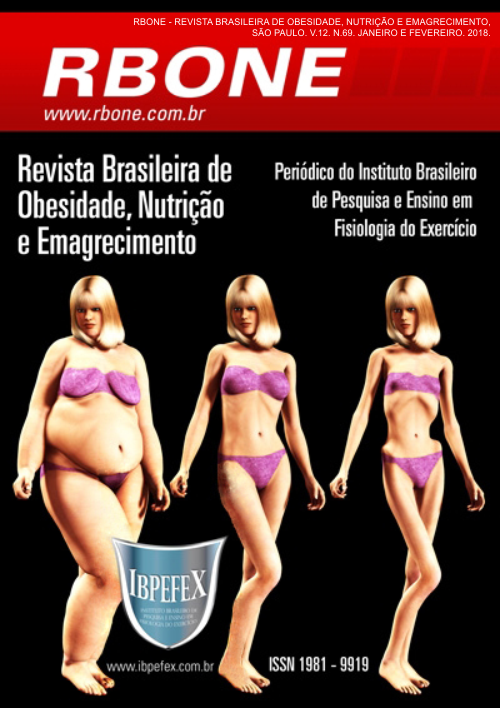Analysis of nutritional composition of sandwiches and urban availability of fast foods networks in Teresina-PI
Abstract
Introduction: Globalization and the growth of food marketing have been increasing the consumption of rich carbohydrate and dense fat products. Aim: To analyze the nutritional composition of large portion sandwiches in fast food chains, as well as the territorial availability of these networks in Teresina-PI. Methods: four networks identified in the study were identified with letters from "A" to "D", the menus of each network were searched on the Internet, three sandwiches of large portions were selected per network, totaling twelve sandwiches analyzed. Results: Of the four analyzed networks, the highest calorie value was in network B with 927.9 kcal. The highest nutrients found were sodium (2079.4 mg) in a single sandwich. Conclusion: It was verified that, of the four networks analyzed, three exceeded macronutrients and daily micronutrients values, resulting in the client being unaware of the nutritional values of the foods.
References
-Associação Brasileira de Indústrias de Alimentação (ABIA). O mercado de food service no Brasil. São Paulo. 2011.
-Brasil. Congresso. Senado. Resolução n. 360, de 2003. Aprova Regulamento Técnico sobre Rotulagem Nutricional de Alimentos Embalados, tornando obrigatória a rotulagem nutricional, através de. Diário Oficial da União; Poder Executivo. Brasília-DF. p. 1-11. 2003.
-Ducatti, R.; Pinto. J.P.A; Sartori, P.M.M. Quantificação de proteína de soja utilizando o método do isótopo (δ (13) C e δ (15) N) para marcas comerciais de hambúrguer de vaca. Meat Science. Vol. 122. p. 97-100. 2016.
-Fedalto, M.B.; Oliveira, J.; Stofella, N.C.F.; Balbi, M.E. Determinação do teor de sal em salgadinhos de milho e possíveis consequências na alimentação infantil. Visão Acadêmica. Vol. 12. Num. 1. 2011.
-Fernandes, M.; Paes, C.; Nogueira, C.; Souza, G.; AQUINO. L.; Borges, F. Perfil de consumo de nutrientes antioxidantes em pacientes com Síndrome Metabólica. Ver Ciênc Méd. Vol. 16. Num. 4-6. p. 209-219. 2007.
-Gomes, G.S.; Degiovani, G.C.; Garlipp, M. R.; Chiarello, P.G.; Junior, A.A.J. Caracterização do consumo de suplementos nutricionais em praticantes de atividade física em academias. Rev. Medicina. Vol. 41. Núm. 3. p. 327-331. 2008.
-Hoffman, M.; Silva, A.C.P.; SiveiroJ. Prevalência de hipertensão arterial sistêmica e inter-relações com sobrepeso, obesidade, consumo alimentar e atividade física, em estudantes de escolas municipais de Caxias do Sul. Ver Pediatria. Vol. 32. p. 163-172. 2010.
-IBGE. Instituto Brasileiro de Geografia e Estatística. Pesquisa de Orçamentos Familiares (POF) 2008-2009: Análise do Consumo Alimentar Pessoal no Brasil. IBGE. 2011. 276 p.
-Lacerda, D.S.; Bock, P.M.; Funchal, C. Consumo exacerbado de lipídeos provoca dano celular em algumas doenças metabólicas e cardiovasculares. Nutrire. Vol. 40. Núm. 2. p. 3. 2015.
-Moita, R. M.; Guerra, A. Entradas e Bandeiras: Estratégia de Interiorização das cadeias de Fast food. Rev. adm. empres. Vol. 52. Núm. 1. p. 85-98. 2011/2012.
-Mcardle, W.D; Katch, F.I; Kacht, V.L. Fisiologia do Exercício: nutrição, energia e desempenho. 7ª edição. Rio de Janeiro. Guanabara Koogan. 2010.
-Mendes, R.S.; Bregman, R. Avaliação e metas do tratamento da proteinúria. Rev. Bras. Hipertens. Vol. 17. Núm. 3. p. 174-177. 2010.
-Rodrigues, T.C; Bernaud, F.S.R. Fibra alimentar –Ingestão adequada e efeitos sobre a saúde do metabolismo. Arq Bras Endocrinol Metab. Vol. 6. Núm. 57. p. 3. 2013.
-Santos, R.D.; Gagliardi, A.C.M.; Xavier, H.T.; Magnoni, C.D.; Cassani, R.; Lottenberg, A.M. Sociedade Brasileira de Cardiologia. I Diretriz sobre o consumo de Gorduras e Saúde Cardiovascular. Arq Bras Cardiol. Vol. 100. p. 1-40. 2013.
Authors who publish in this journal agree to the following terms:
- Authors retain the copyright and grant the journal the right of first publication, with work simultaneously licensed under the Creative Commons Attribution License BY-NC which allows the sharing of the work with acknowledgment of the authorship of the work and initial publication in this journal.
- Authors are authorized to enter into additional contracts separately for non-exclusive distribution of the version of the work published in this journal (eg, publishing in institutional repository or book chapter), with acknowledgment of authorship and initial publication in this journal.
- Authors are allowed and encouraged to post and distribute their work online (eg, in institutional repositories or on their personal page) at any point before or during the editorial process, as this can bring about productive change as well as increase impact and impact. citation of published work (See The Effect of Free Access).






